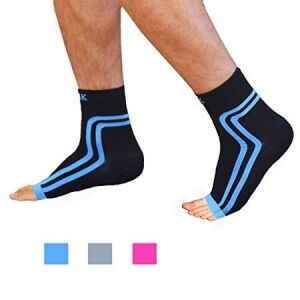Plantar Fasciitis Socks: Do they work?
Plantar fasciitis socks have recently gained popularity as a cost-effective home remedy for plantar fasciitis. A quick internet search will return dozens of websites flogging their wares, claiming to heal your plantar fasciitis. From footless, to knee length, black, nude or purple, with or without a gel heel, and even those that include pouches for ice packs or splints or straps for support, the options for plantar fasciitis socks seem endless and incredibly confusing. Prices also seem to vary considerably, from around $10 all the way up to $50. To compound the issue further, it can be incredibly easy to get lost in all the medical jargon on the product descriptions.
But at the end of the day (no pun intended!), Do plantar fasciitis socks even work?
The short answer to this commonly asked question about the efficacy of plantar fasciitis socks is we don’t really know. Whilst there seems to be a fair amount of anecdotal evidence out there on the World Wide Web from people who suggest that plantar fasciitis socks healed their condition, there is no published, peer-reviewed clinical evidence to suggest that this is scientifically true.
As a sports podiatrist and medical professional, I need to consider medical facts. It is imperative that the treatments that we use in practice are not only safe, but effective and proven. Plantar fasciitis socks do not yet fall into this category of treatment. Interestingly, whilst writing this post, we came across one website claiming to link their product back to a clinical trial, however when we followed their link to read the evidence for ourselves, no such article existed.

So what about all the people out there who say that plantar fasciitis socks treated their condition? Well, that is a big call to make, and a complicated one at that. The reason is simple: in the field of medical science, or in any scientific field for that matter, for a claim to efficacy to be made, there must have been at least one, but usually many reproducible trials. And when a trial is conducted, there are ‘rules’. These rules refer to the scientific principles that must be followed so that studies remain unbiased and valid. In very short and simple terms, there are variables that must be correctly controlled, so that results can be accurately statistically analyzed to produce meaningful conclusions, which can be reproduced again and again.
For example, if a study was to be carried out on the efficacy of plantar fasciitis socks in treating plantar fasciitis in patients, the researchers would need to consider and control variables such as the type of footwear the patients wear, the number of steps the patients take, notes on any physical activity the patients engage in, the severity or degree of injury of the patients’ plantar fasciitis to begin with, and bodyweight, gender, and related medical conditions, just to name a few. Researchers would need to consider how they would avoid biased reporting or ‘placebo effect’ in patients, and how they would tangibly measure the healing effect of the plantar fasciitis socks.
So then how are plantar fasciitis socks giving people relief? At a glance, they are offering some pain relief due to their compression. Now, your sports podiatrist would tell you that compression is widely accepted as an effective way to reduce swelling and inflammation. But it can be achieved with correct strapping technique, no fancy overpriced plantar fasciitis socks necessary. It is also highly unlikely that compression alone is enough to allow an injured plantar fascia to heal. As mentioned previously, any other treatments or remedies that the patient is concurrently using, would also be affecting the healing and pain relief process. Whilst using their socks, perhaps they have been resting their feet more, perhaps they have been using some prescribed exercises, perhaps they are using cold therapy or other treatments…without this information, we cannot draw conclusions.
Okay then, what treatments other than plantar fasciitis socks exist, that are proven to work?
If you are suffering with plantar fasciitis, rather than purchasing plantar fasciitis socks, speak to your sports podiatrist about clinically proven treatments. Some examples of such treatments include custom-made orthotics, which support the patient’s arch appropriately, unloading the plantar fascia and allowing it to heal, and shockwave therapy, which is proven to stimulate blood flow, tissue regeneration and provide almost instant pain relief.
The sports podiatrists at our clinic do not currently stock plantar fasciitis socks, nor do we plan to do so in any foreseeable future. This is simply due to the lack of credible scientific evidence regarding the product. This is not to say that plantar fasciitis socks do not have a place in providing some relief to people with foot conditions; they may provide some benefits to people who have fatigued feet or other conditions, but as it currently stands, there is a lack of evidence of their efficacy for treating plantar fasciitis.
Please be aware that the information provided in this post should not be taken as general medical advice. It is intended to be informational only. If you are suffering with plantar fasciitis, you should consult a sports podiatrist for a proper diagnosis and a tailored treatment plan. Please be mindful of the evidence before purchasing plantar fasciitis socks.
Sydney Heel Pain Clinic – 93883322
Written by Karl Lockett, Sports Podiatrist


